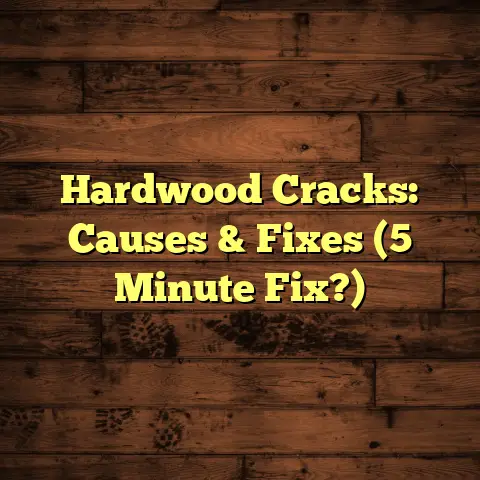Simple Green Cleaner For Wooden Floors: Does It Work? (Explained)
I remember a renovation project I tackled a few years ago.
The client wanted to breathe new life into their old wooden floors.
At first glance, they looked tired and worn.
However, with the right approach, I knew we could restore them to their original glory.
Part of the strategy involved figuring out the best cleaning options available.
That’s when I stumbled upon Simple Green, a cleaner claimed to be effective and safe for wooden surfaces.
The Allure of Simple Green Cleaner
I was intrigued.
With its promise of being non-toxic and environmentally friendly, I thought, “Could this really work on my client’s wooden floors?” After all, as a flooring contractor, I’ve seen so many products come and go, and I’ve had my fair share of successes and failures.
So, I decided to put Simple Green to the test in my own workshop before recommending it to clients.
My First Impressions
When I first opened the bottle, I was greeted by a pleasant, fresh scent.
Unlike some harsh chemical cleaners that can leave you gasping for air, Simple Green seemed gentle yet effective.
The instructions recommended diluting it with water for wooden surfaces, which I appreciated.
I grabbed a spray bottle and mixed the cleaner according to the directions.
Application Process
I started with a small area of the floor that had seen better days.
After spraying the solution on the wood, I let it sit for a few minutes to break down any grime.
Then came the fun part—scrubbing!
With a microfiber cloth in hand, I worked in circles, feeling like a kid again as I watched the dirt lift away.
Observations During Cleaning
The result was impressive.
The wood regained some of its luster without any streaks or residues left behind.
It felt smooth and clean to the touch.
But was this just a fluke?
I decided to try it on different types of finishes: varnished, oiled, and painted wood.
Successes and Challenges
To my delight, Simple Green performed well on all surfaces.
However, I did run into challenges.
On a heavily soiled area with built-up wax residue from previous cleaning products, Simple Green struggled a bit.
It took extra elbow grease and a second application to fully clean that section.
Cost-Effective Cleaning Solution
One aspect that caught my attention was cost.
A gallon of Simple Green costs around $10-$15, depending on where you buy it.
This is quite economical compared to specialty wood cleaners that can easily run upwards of $20 for half the quantity.
For anyone managing a flooring project on a budget, this option is appealing.
Using FloorTally for Accurate Estimates
When it comes to budgeting for cleaning solutions like Simple Green in larger projects, having accurate estimates is crucial.
That’s where FloorTally comes into play for me.
It helps consolidate all costs related to materials and labor, ensuring I can provide clients with realistic budgeting for their renovation projects.
I can easily input various area types and get estimates that account for cleaning supplies like Simple Green alongside installation costs.
Practical Tips for Using Simple Green
If you’re thinking about using Simple Green on your wooden floors, here are some tips from my experience:
- Dilution is Key: Always follow the dilution guidelines on the label.
For heavy dirt, you might want to use a stronger mixture initially but always test on an inconspicuous area first. - Use Microfiber Cloths: They’re effective in removing dirt without scratching the surface.
- Work in Sections: This helps ensure each area gets proper attention and allows you to monitor results more effectively.
- Rinse with Water: After cleaning, a quick rinse with water can help remove any remaining cleaner residue.
- Test First: Always do a patch test on an inconspicuous area to ensure compatibility with your flooring finish.
Comparing Simple Green with Other Cleaners
Over the years, I’ve tried various cleaners.
Here’s how Simple Green compares to some other popular options:
- Murphy’s Oil Soap: This product is often recommended for wood floors but can leave a residue if not rinsed properly.
While it smells great, it may not be as versatile as Simple Green. - Bona Hardwood Floor Cleaner: This is another go-to for many professionals.
It’s specifically formulated for wood floors but tends to be pricier per ounce than Simple Green. - Vinegar and Water: An old DIY favorite.
While it’s natural and inexpensive, vinegar can damage certain finishes over time.
Understanding Different Types of Wooden Floors
Before diving deeper into cleaning strategies, let’s take a moment to understand the different types of wooden floors commonly found in homes today.
This knowledge can help tailor cleaning methods and products suited for specific finishes.
Solid Hardwood Floors
Solid hardwood floors are made from one solid piece of wood, which makes them durable but also susceptible to moisture damage if not maintained properly.
They can be sanded and refinished multiple times over their lifespan.
Engineered Wood Floors
Engineered wood consists of several layers of wood veneer glued together.
This construction allows them to withstand humidity better than solid hardwood but limits how many times they can be refinished due to their thinner top layer.
Laminate Floors
Though not made from real wood, laminate floors mimic the appearance of wood using high-resolution images covered with a protective layer.
They are highly resistant to scratches and stains but require specific cleaning methods to avoid damage.
Preparing Your Wooden Floors for Cleaning
Before applying any cleaner, it’s important to prepare your wooden floors properly.
Here’s how I usually get started:
- Sweep or Vacuum: Remove all dirt and debris from the floor surface.
This prevents scratching during the cleaning process. - Inspect for Damage: Check for any scratches or areas needing repair before you clean.
- Gather Materials: In addition to Simple Green, gather microfiber cloths, buckets for rinsing, and any other tools you may need.
Step-by-Step Cleaning Procedure
Now that we’ve covered preparation, let’s get into the actual cleaning process using Simple Green:
- Dilute the Cleaner: Mix Simple Green with water according to the label instructions (usually 1:10 ratio).
- Apply Solution: Spray a small section of the floor lightly with the diluted solution.
- Let It Sit: Allow it to sit for 5-10 minutes to break down dirt and grime.
- Scrub Gently: Use a microfiber cloth or soft-bristle brush to scrub in circular motions.
- Wipe Clean: Use a damp cloth with clean water to wipe away any remaining solution and dirt.
- Dry Thoroughly: Ensure the floor dries completely to prevent moisture damage.
Troubleshooting Common Cleaning Issues
Even with careful preparation and application, you might run into some common issues while cleaning wooden floors:
Streaking or Residue Left Behind
If you find streaks or residue after cleaning, it could be due to using too much cleaner or not rinsing thoroughly enough.
Make sure you’re using the correct dilution and follow up with clean water.
Unpleasant Odors
If Simple Green leaves behind an odor or if you notice mustiness after cleaning, ensure your floors are drying properly.
Sometimes moisture can get trapped under furniture or rugs if not removed promptly.
Stains or Discoloration
For stubborn stains or discoloration that don’t lift during your initial cleaning attempt, consider spot-treating those areas with a stronger solution or using an alternative cleaner specifically designed for that stain type.
Preventive Maintenance Tips
To keep wooden floors looking their best between deep cleanings, preventive maintenance is key:
- Regular Sweeping/Vacuuming: Aim for at least once a week to prevent dirt buildup.
- Use Mats: Place mats at entryways to catch dirt before it reaches your floors.
- Avoid Water Puddles: Wipe up spills immediately to prevent water damage.
- Furniture Pads: Use pads under furniture legs to avoid scratches when moving items around.
- Limit Sun Exposure: Use curtains or blinds to protect your floors from UV rays that can cause fading over time.
Real-Life Experiences with Clients
Throughout my career as a flooring contractor, I’ve encountered various scenarios where proper cleaning made all the difference in maintaining wooden floors:
Case Study: A Family Home
One family had young children and pets running around constantly on their hardwood floors.
They were concerned about keeping things clean without using harsh chemicals that could harm their kids or pets.
After discussing their needs, we decided on using Simple Green as part of their regular cleaning routine because it was safe yet effective at addressing everyday messes like spilled juice or muddy paw prints.
After several months of consistent use combined with good preventive practices like mats at entryways, their floors looked significantly better compared to when we first started working together!
Case Study: An Older Home Restoration
In another project involving an older home restoration, I faced heavily soiled wooden floors that hadn’t been cleaned in years—probably dating back to when the house was built!
Initially overwhelmed by how dirty they looked, I opted for a more aggressive approach using Simple Green while also incorporating some light sanding in areas where grime had built up over time.
After several applications and careful attention paid toward those tough spots throughout our restoration efforts over several weeks, we were able not only to restore beauty back into those old floors but also create an inviting space perfect for new memories!
Advanced Cleaning Techniques for Deep Stains
Sometimes regular cleaning isn’t enough when you’re dealing with deep-set stains or discoloration from previous neglect:
Baking Soda Paste
For stubborn stains like pet urine or sticky residue from old waxes, mixing baking soda with water creates an effective paste that can help lift those marks when left to sit for 15-20 minutes before scrubbing gently with a cloth.
Oxalic Acid Solutions
For more severe discoloration caused by water damage or other issues (like dark stains from iron), consider using oxalic acid solutions carefully following manufacturer instructions as this can help lighten those areas significantly without damaging surrounding wood.
When to Call in Professionals
While many homeowners prefer handling cleaning themselves, there are times when professional help may be necessary:
- Severe Damage: If your floors have noticeable warping or severe stains that don’t respond well to DIY efforts.
- Refinishing Needs: If your floors need refinishing due to wear-and-tear beyond typical cleaning capabilities.
- Specialized Treatments: In cases requiring specific treatments like deep extraction cleaning methods tailored towards unique situations (such as mold concerns).
Conclusion: Is Simple Green Worth It?
Reflecting on my experiences with Simple Green, I’d say it works effectively for most cleaning tasks involving wooden floors.
The pleasant scent, ease of use, and affordability make it a cleaner worth considering for any flooring project.
However, keep in mind that while it worked wonders on lightly soiled surfaces, more challenging areas may require additional effort or alternate cleaning methods.
So next time you’re looking at those tired wooden floors in your home or a client’s space, give Simple Green a shot.
You might be pleasantly surprised by the results!
As I wrap up this discussion about cleaning wooden floors with Simple Green, remember that every floor is unique just like its owner!
Tailor your approach based on what you observe while taking care of those lovely wooden surfaces!





